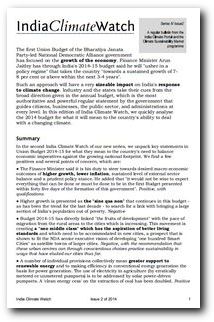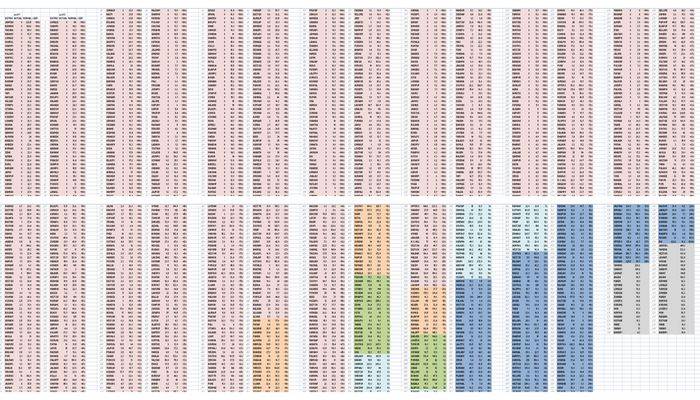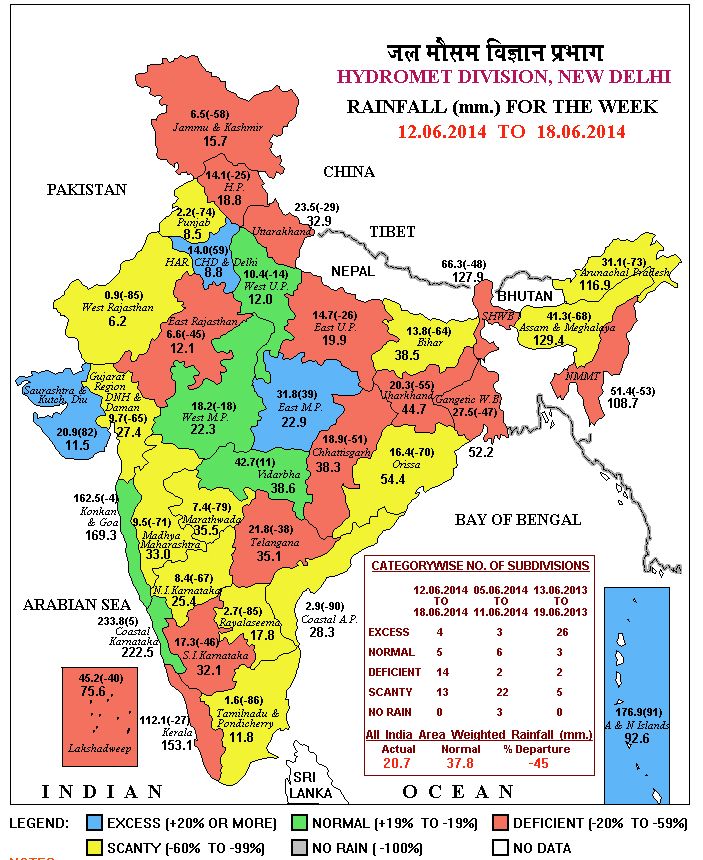
A panel of charts that show India’s energy consumption, imports, and dependence on fossil fuel.
Electricity as fundamental right and energy convenience as the basis of ‘development’ in Bharat and in India. If this is what Piyush Goyal means when he says his government is “is committed to ensure affordable 24×7 power” then it will come as yet another commitment that supports energy provision and consumption as the basis for determining the well-being of Bharat-vaasis and Indians (the UPA’s Bharat Nirman was the predecessor). But the Minister of State (Independent Charge) for Power, Coal and New and Renewable Energy cannot, using such a promise, ignore the very serious questions about the kind of ‘development’ being pursued by the NDA-BJP government and its environmental and social ramifications.
Goyal has said, via press conferences and meetings with the media, that the NDA government is committed to ensuring affordable power at all times (’24 x 7′ is the expression he used, which must be banished from use as being a violent idea – like nature our lives follow cycles of work and rest and ’24 x 7′ violently destroys that cycle). Goyal has promised, pending the taking of a series of steps his ministry has outlined, that such a round the clock provision of electric power will be extended to “all homes, industrial and commercial establishments” and that there will be “adequate power for farms within five years”.

The summary of India’s power generation capacity, by type and by region. Source for data: Central Electricity Authority
Some of the very serious questions we raise immediately pertain to what Goyal – with the help of senior ministry officials and advisers – has said. The NDA-BJP government will spend Rs 75,600 crore to (1) supply electricity through separate feeders for agricultural and rural domestic consumption, said Goyal, which will be used to provide round the clock power to rural households; and (2) on an “integrated power development initiative” which involves strengthening sub-transmission and distribution systems in urban areas. This is part of the “transformative change” the ministry has assured us is for the better. Goyal and his officials see as a sign of positive transformation that coal-based electricity generation from June to August 2014 grew by nearly 21 per cent (compared with the same months in 2013), that coal production is 9% higher in August 2014 compared with August 2013, and that Coal India (the largest coal producer company in the world which digs out 8 of every 10 tons of coal mined in India) is going to buy 250 more goods rakes (they will cost Rs 5,000 crore) so that more coal can be moved to our coal-burning power plants.
 We must question the profligacy that the Goyal team is advancing in the name of round the clock, reliable and affordable electricity to all. To do so is akin to electoral promises that are populist in nature – and which appeal to the desire in rural and urban residents alike for better living conditions – and which are entirely blind to the environmental, health, financial and behavioural aspects attached to going ahead with such actions. In less than a fortnight, prime minister Narendra Modi (accompanied by a few others) will attend the United Nations Climate Summit 2014. Whether or not this summit, like many before it, forces governments to stop talking and instead act at home on tackling anthropogenic climate change is not the point. What is of concern to us is what India’s representatives will say about their commitment to reduce the cumulative impact of India’s ‘development’, with climate change being a part of that commitment.
We must question the profligacy that the Goyal team is advancing in the name of round the clock, reliable and affordable electricity to all. To do so is akin to electoral promises that are populist in nature – and which appeal to the desire in rural and urban residents alike for better living conditions – and which are entirely blind to the environmental, health, financial and behavioural aspects attached to going ahead with such actions. In less than a fortnight, prime minister Narendra Modi (accompanied by a few others) will attend the United Nations Climate Summit 2014. Whether or not this summit, like many before it, forces governments to stop talking and instead act at home on tackling anthropogenic climate change is not the point. What is of concern to us is what India’s representatives will say about their commitment to reduce the cumulative impact of India’s ‘development’, with climate change being a part of that commitment.
At the UN Climate Summit 2014, it will be heard (in as many languages as there are translators available for them) that energy demand is growing along with expanding global wealth (but the UN will not say how unequally that extra wealth has been distributed). There will be grave references made to growing populations with a large number still without the round the clock electricity that Goyal has promised. Many speakers (eminent experts, as the UN system calls them) will be mobilised to remind the gathering that a shift toward renewable sources of energy (such as solar, wind and geothermal) is needed, that greater energy efficiency in appliances, buildings, lighting and vehicles are needed, and that this is so because it is essential to use the world’s resources sustainably, to diversify economies and successfully address the challenge of climate changes. It will sound suitably solemn and uplifting at the UN headquarters in New York, but the story at home in Bharat and India is solemn and deeply worrisome.
Some of the tale is of very short-term inconvenience, such as when Mumbai went without electricity for a few hours on 02 September. The business and financial media reported that “back-up generators at banks and brokerages ensured that financial business was largely unaffected” and then circulated the familiar complain that India does not generate enough electricity to meet rapidly rising demand, that a severe shortage of coal (half our 150-odd coal burning plants are reported as having no more than a week’s supply of coal) has raised fears of more widespread blackouts.
Dire tweets from a leading industrialist, Anand Mahindra, were also reported: “Dark office in Mumbai. Lights out in the whole area. The coal crisis is beginning to literally show its dark side. A threat to the India story.” This senior member of the clutch of companies on the Bombay Stock Exchange ‘A’ List underlining a threat to the ‘India story’ led the business and financial media to quickly exert psychological duress on the NDA-BJP – “any grid collapse would cast doubt on the crisis management skills of the new government led by Prime Minister Narendra Modi”.
Electricity as fundamental right and energy convenience is moreover essential in the view of Indian industry to reaching the 8% per year GDP growth threshold, which this section appears to consider the single goal of the Republic of India. Hence where energy and the generation and provision of electricity is concerned, Goyal and his team have listed eight steps their ministry will undertake: (1) to rationalise coal supplies (by which is meant, as far as I can make out, move coal fewer kilometres to nearer power plants instead of distant ones); (2) create a statutory coal regulator; (3) civil nuclear cooperation agreement (Australia mentioned for uranium); (4) surveillance at major coal mines to control coal theft; (5) hydro-electric power generation in Jammu and Kashmir (“fast track” they say); (6) environmental clearances (“government will speed up environment and forest clearances to projects”); (7) bring more generation capacity at gas-based power online; (8) clear the solar ultra mega power plant at Sambhar near Jaipur, Rajasthan (the area is a site for migratory birds and an ecological refuge).
Had we an environment regulatory system and a project appraisal and clearances mechanism that protected environment, biodiversity, natural resources and our natural heritage, points 3, 5, 6 and 8 could under no circumstance have appeared on the Ministry of Power list. But the NDA-BJP government has in its first three months taken swift steps to eases clearances for industrial and infrastructure projects. Goyal’s colleague in the cabinet, Prakash Javadekar (minister of state for environment, forests and climate change), has worked to get the MoEF&CC to loosen the norms for expansion of coal mining projects producing up to 8 million tonnes of coal a year, and to adopt a ‘cluster approach’ in clearing smaller mines in the coal-rich belts of India. The environment ministry is also – as the Rajya Sabha was told – “streamlining environmental clearance process by delegating more powers to the State level Environment Impact Assessment Authorities (SEIAAs) for granting” such clearances, and neither house of Parliament has inquired critically as to whether the states so favoured have in place the evaluating expertise and capacities of sufficient authority and independence to not clear those projects which will harm environment, biodiversity, natural resources and our natural heritage.

Poor ambient air quality in our cities is hazardous to health, and emissions from coal-burning power plants are an important contributor to urban air pollution. This chart of a New Delhi region is courtesy Asia Air Pollution Real-time Air Quality Index (AQI).
While industry and a growing urban middle class expect ‘development’ and convenience, represented mainly by uninterruptible kilowatts, and exert a disproportionate amount of pressure on the state to fulfil these desires, there is a short list of steps very different from Goyal’s which must be recognised by the NDA-BJP government and state governments. This is:
(1) There is 172,986 MW of thermal power capacity (149,178 coal, 22,608 gas and 1,200 diesel), 40,798 MW of hydro-electric, 31,692 MW of renewables and 4,780 MW of nuclear, for a total of 250,257 MW. That’s on paper, whereas the actual power generation every average day (in 2014, according to the Central Electricity Authority, which is the apex power sector planning body) has been around 135,000 MW. From every power plant to every grid and to every distribution network, the aggregate transmission and commercial losses are estimated to be 26%. Judging from the trend of 2000 onwards, India’s coal consumption would have been 710 million tons in 2013 – almost twice the consumption in 2000 (359 mt) and more than three times the consumption in 1990 (224 mt).
To have allowed 26% of the generated electricity in 2013 to be ‘lost’ amounts to wasting the coal that was burned to generate it, and this is a gigantic sum, an amount equal to the 189 mt that India consumed in 1986. Secretary Pradeep Kumar Sinha, Additional Secretaries R N Choubey and Devendra Chaudhry, Joint Secretaries Mukesh Jain, B N Sharma, Pradeep Kumar, Satish Kumar and Jyoti Arora, and Economic Adviser Raj Pal must practice thrift and saving instead of entertaining industry’s demands for more power plants.
(2) India has for the last year consumed crude oil at the rate of about 3.5 million barrels a day and of this astounding amount 2.5 million barrels are imported. For 2013-14 (until 31 March) India’s appetite for crude oil cost US$ 143 billion (which represented 32% of India’s total imports for the financial year, according to the Ministry of Commerce). The standard oil barrel contains 159 litres of crude oil and, according to the Society of Petroleum Engineers, a barrel of crude oil represents about 1,700 kWh of electricity. Judging from the power consumption trend from 2000, our per capita average annual electricity consumption in 2014 will be 750-760 kWh, which is about 62 or 63 units a month.

A simple schematic for a 1,000 MW coal-burning power plant that shows the inputs and pollutants. Diagram courtesy Indian Power Sector.Com
Thus a single barrel of imported (or domestically produced) crude oil contains energy enough to supply two persons for a year, at current annual averages. Such a comparison between fuels is useful to illustrate what the country’s automobile addiction costs in terms of what it takes to furnish households with electricity. About 47% of the oil is used (after refining and being turned into various petroleum products) for transport, supporting an automobile industry that has placed 17.56 million cars, 2.01 million taxis, 3.9 million jeeps, 4.24 million light motor vehicles, 1.29 million buses, 7.37 million goods carriers, 9.42 million other vehicles (tractors, three-wheelers and so on), and 115.41 million two-wheelers, on our roads to congest our towns and cities into paralysis.
The oil import bill is Rs 872,300 crore, a number that defies the citizen’s attempts to size it (it is more than ten times the wages paid through MGNREGA (about Rs 78,106 crore) for the last three years for which 235.5 million people were provided wage employment). Goyal and his officials are therefore better advised to pay attention (together with cabinet colleague Nitin Gadkari, the minister of road transport and highways) to the 119,209 state transport buses in Bharat and India in which we travelled (economically and fairly reliably, round the clock too) some 552 million passenger kilometres.
(3) This NDA-BJP government in its first three months has blundered just as much as its predecessor government did on matters that concern every citizen: the environment, energy, the provisioning of agriculture and food, and human development. At every turn Goyal’s cabinet colleagues, and in particular Arun Jaitley, minister of finance and defence, have chanted out the tiresome refrain that India will grow, must grow, must build, must consume, must produce and so on. Their obduracy in the face of evidence to the opposite – evidence that has been available in Bharat and internationally from the time they were students, certainly – is just as tiresome. Gathering ever more citizens into the club of the urban middle class will only lead to a financial and technological trap from which there is no escape.
One example amongst many illustrates why, quite starkly. Since 2004, the sale of room air-conditioners has grown at about 15% per year, and the industry reported sales of over 3.5 million air-conditioners in 2013. Concerned by the demand for electricity from homes and offices fitted, over the last three years, with new air-conditioners, the Bureau of Energy Efficiency (a statutory body under the Ministry of Power) set out to estimate what effect millions of new air-conditioners would have on peak electricity demand. The answer was provided by an ‘expert group on low carbon strategies for inclusive growth’ for the Planning Commission and independent analysis conducted by the Lawrence Berkeley National Laboratory (of the USA). This study found that peak electricity demand would rise by 75,000 MW to reach 150,000 MW by 2030. That is, in 15 years the peak electricity demand alone will be 60% of today’s total power generation capacity in India!
There is no financial fix and there is no technological fix for such a trend. There is no further excuse for the NDA-BJP government and for ministers like Goyal, Jaitley, Javadekar, Gadkari (and prime minister Modi) to continue to ignore the obvious. Goyal and Jaitley both need an immediate refresher in revisiting the reasons why the marginal cost curve of any action they have announced in the last three months will rise steeply. That rise will be due to a combination of activities, and the natural consequences, which will ruinously amplify the impacts of a changing climate. Bharat cannot continue to shirk the duty – of government and of citizen – of caring first for our ‘prakruti’ (what the west has recently begun to call ecological services) and instead pursuing the ‘maya’ of continuous growth.
– Rahul Goswami
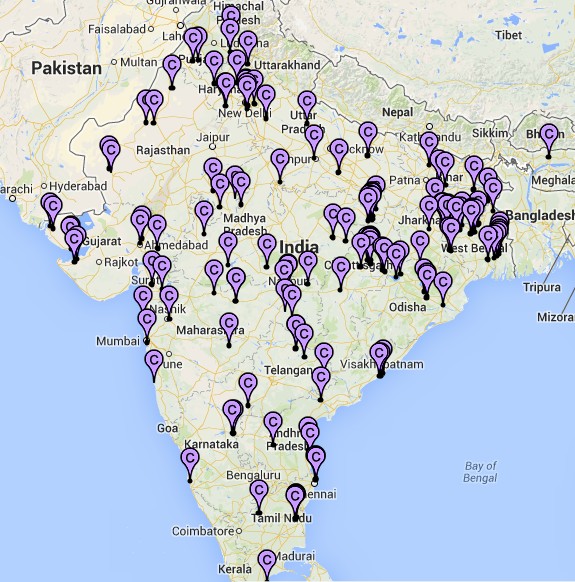




 quibbling by both Ramesh and Dasgupta are of very little use locally in India. That is why we think the Centre for Policy Research and similar institutes and establishments which study climate change in all its perplexing colours (none of them more frustrating than the UN negotiations) must alter the subject – to the ‘whom’ of people where they live rather than the ‘what’ of negotiating positions.
quibbling by both Ramesh and Dasgupta are of very little use locally in India. That is why we think the Centre for Policy Research and similar institutes and establishments which study climate change in all its perplexing colours (none of them more frustrating than the UN negotiations) must alter the subject – to the ‘whom’ of people where they live rather than the ‘what’ of negotiating positions.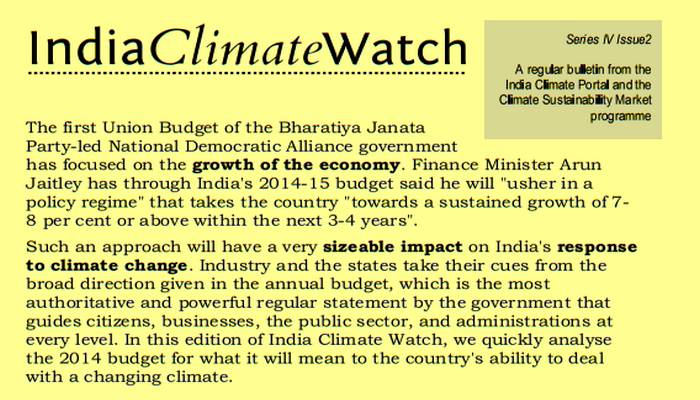 The first Union Budget of the Bharatiya Janata Party-led National Democratic Alliance government has focused on the growth of the economy. Finance Minister Arun Jaitley has through India’s 2014-15 budget said he will “usher in a policy regime” that takes the country “towards a sustained growth of 7-8 per cent or above within the next 3-4 years”.
The first Union Budget of the Bharatiya Janata Party-led National Democratic Alliance government has focused on the growth of the economy. Finance Minister Arun Jaitley has through India’s 2014-15 budget said he will “usher in a policy regime” that takes the country “towards a sustained growth of 7-8 per cent or above within the next 3-4 years”.